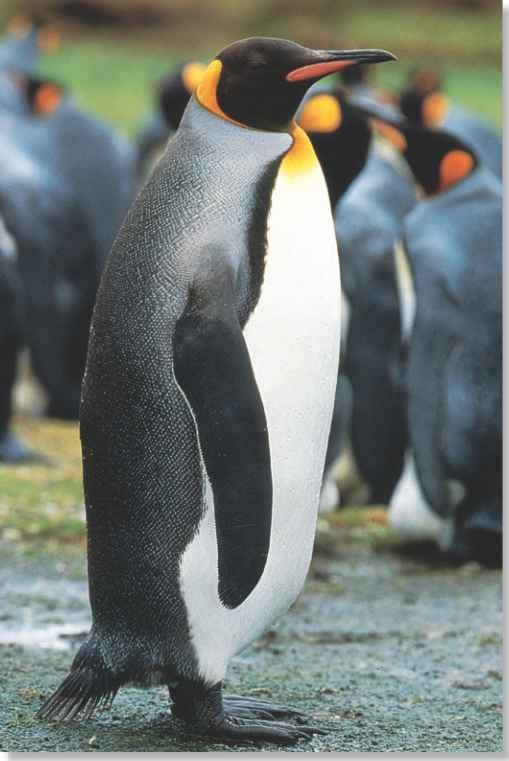ORDER
Sphenisciform.es
FAMILY
Spheniscidae
GENUS & SPECIES
key features
• Holds record among I all birds for longest fledging period (up to 13 months) .
• Can distinguish its chick’s call out ‘ of thousands when returning from the sea with food
• Survives the intense cold with the help of increased metabolism, a thick layer of blubber beneath the skin and specialized feathers
where in the world?
Found on at least eight sub-Antarctic islands, including Marion and Macquarie Islands, in the southern Atlantic and Pacific Oceans j between 46-55° S
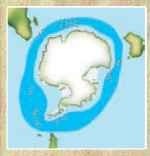
Lifecycle
A black-and-white blanket forms over sub-Antarctic islands as king penguins cluster during incubation. The mass of huddled juveniles resembles a giant fuzzy carpet.
HABITAT
The king penguin spends most of its time in the icy waters of the Antarctic; penguins gather on land mainly to reproduce and molt on sub-Antarctic islands such as Crozet and Macquarie. Penguin colonies of hundreds of thousands huddle together to combat the intense cold. Natural enemies in these frigid temperatures include leopard seals and killer whales. Penguins avoid these predators with countershading: from above they blend with the jet-black depths, from below with the white ice.
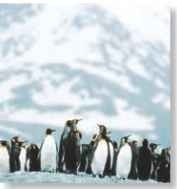
A chill in the air
Warmer than the Antarctic, sub-Antarctic islands are still intensely cold.
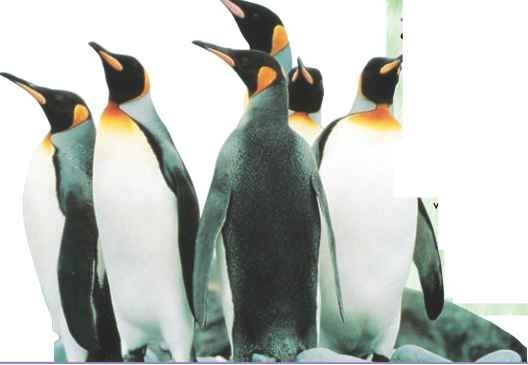
BREEDING
King penguins remain in colonies throughout the year, but always return to their ancestral nesting sites to lay their eggs and rear their young. The penguin builds no nest. Instead, it balances a single egg on top of its feet, bending over so that a skin fold covers and warms the egg. Parents take turns incubating the egg. Upon hatching, the soft, downy chick remains on its parent’s feet for about 35-40 days until it grows too large to be warmed. When both parents go off to sea in order to feed their chick’s growing appetite, chicks gather together in large creches that help keep them warm and protected from the skua, a predatory bird. Returning parents find their chick by listening for its call, which is literally unique among thousands. It enables parents to identify and feed their own chick. The egg-laying and chick-rearing process takes about 15 months, which is why king penguins breed only twice in three years.
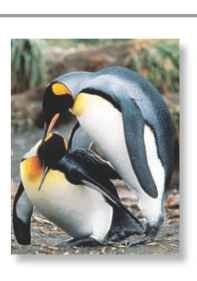
CONSERVATION
The king penguin, once slaughtered for its blubber and skin, was eliminated from the Falkland Islands in the 1870s. It took about 50 years for penguins from major colonies elsewhere to find their way to South Georgia in the Falklands and occupy rookeries there. King penguin populations are currently stable.
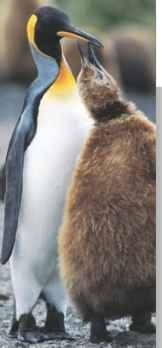
FROM EGG TO ADOLESCENT

Getting ready…
“Wall-to-wall” on muddy flats while incubating their egg, king penguins keep their neighbors in place by the jab of a beak.

New arrival…
The female has returned to feed some regurgitated fish to its 2-week-old. The male now goes out to sea for a meal.
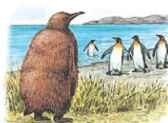
Baby food…
Groups of chicks, called creches, provide warmth and protection when both parents go to search for food.
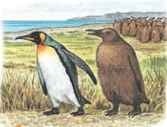
Growing up
A 10-month-old chases its mother, begging for more food. It will join the creche until both parents return with more food.
Food & feeding
As Antarctic ice breaks up during the longer summer days, tiny floating plants, known as phytoplankton, grow rapidly These plants supply nutrients for zooplankton and the shrimplike krill, a staple of the king penguin’s diet. Krill swim in schools in the top 150′ of the sea, a depth easily reached by the penguin. Diving an average of 160′ with a maximum dive of 800′, the penguin seems to “fly” through the water in pursuit of prey, which includes lan-ternfish and squid. The king penguin can ingest larger food than other penguins since the span
between the tips of its opened bill is greater.
A Ravenous chick The chick’s blubber serves as an energy source to cope with the irregular feedings from its parents.
Behavior
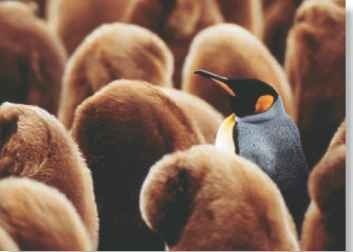
A My child’s call Parents can distinguish their own chick’s call among thousands when returning from feeding trips at sea.
Gregarious king penguins flock together on land and in the sea. They waddle comically, tilting their heads to and fro, focusing with one eye then the other Since they glide faster than they walk, penguins often toboggan toward their nesting sites, following a voluntary leader.
At sea, the paddlelike wings propel the penguin, while the legs, feet and tail provide steerage. The penguin leaps through the air every few yards, clearing the surface mainly to breathe. Leaping also keeps it from becoming easy prey Insulation alone is insufficient to maintain a safe body temperature in the water, so the penguin’s metabolism increases during its dives. The penguins return to land to molt. During molting, islands are covered in feathers, as the penguin loses them in large patches while new ones appear. The new feathers will not become waterproof for several weeks. As a result, the penguin is unable to dive in the water in search of food and often loses 30% or more of its bodyweight.
Early Antarctic explorers thought the brown, down-covered king penguin chicks were a totally separate species and called them the woolly penguins.
The name “penguin” was originally given to the now extinct great auk, a large, flightless, black-and-white bird with an extremely upright stance.
The egg has a chalky-white surface that can easily be removed. Underneath is a harder layer with a pale-green color that intensifies during incubation.
PROFILE
King Penguin
A flightless bird, the king penguin is adapted for aquatic existence and is able to “fly” underwater with great speed and agility.
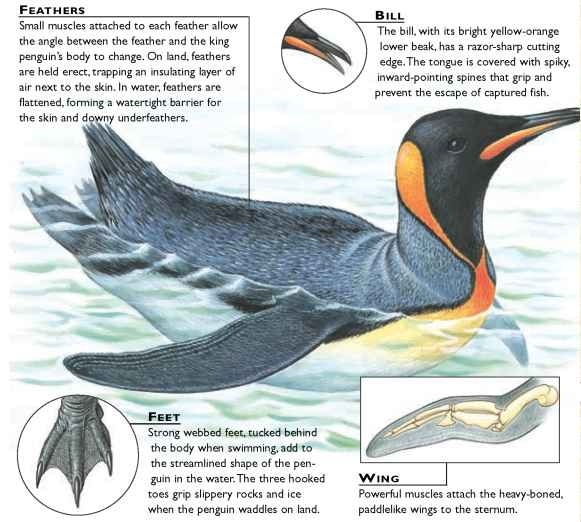
Creature comparisons
The gentoo penguin (Pygoscelis papua) is a close relative of the king penguin but is considerably smaller at 30″. The gentoo’s black head and irregular
white patch above the eye contrast with the large orange patches on the sides of the king penguin’s head and neck. The gentoo’s breeding grounds range from the Falklands to the South Georgia and Kerguelen Islands, much like the king penguin. Unlike the king penguin, which makes no nest, the gentoo penguin builds a nest out of bones, feathers, grass and stones. It lays two eggs, as opposed to the king penguin’s one, but like the king, both male and female share incubation.


| vital statistics | |
| Weight | 30-40 lbs. |
| Length | 36-38″ |
| Sexual Maturity | 3-8 years, usually 5-6 |
| Breeding Season | November-April; lays egg early one season, late the following season |
| Number of Eggs | 1 |
| Incubation Period | 54 days |
| Fledging Period | 10-13 months |
| Breeding Interval | Breeds twice in 3 years |
| Typical Diet | Fish, squid and krill |
| Lifespan | 17-20 years |
Related species
• Penguins are the . largest group of flightless birds, with 17 species in six genera. While most species have black backs, the king, emperor and little blue penguin have blue-gray backs. The low mortality rate in the king penguin’s genus, Aptenodytes, seems to be linked to the laying of a single egg. King and emperor penguins each lay one egg.
